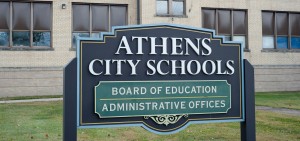
Survey: Some Athens High School Students claim Verbal Harassment at the Middle School
By: Maggie Shandrick
Posted on:
ATHENS, Ohio — A survey of 450 former Athens Middle School students found that some were verbally harassed by Ohio University students while on their way to school.
The survey, conducted by a member of the Athens Schools Facilities Steering Committee, showed that 17 percent of the high school students responding faced some kind of harassment from university students while they attended Athens Middle School. The survey was conducted to help determine the future of the aging Athens Middle School, located just blocks from the Ohio University campus.
In reviewing the survey during Monday night’s meeting of the steering committee, one former middle school student reported she had to take a different route to avoid harassment from an intoxicated OU student.
Athens Schools Superintendent Tom Gibbs told the committee that he had not heard of those reports before the survey was presented to the committee. He said he would be looking into those reports.
The committee is made up of representatives of all city schools, board appointees, the Athens Education Association, a representative from Ohio University, and the Athens mayor. Fewer than 10 members of the public turned out for the meeting which saw discussion of the development of a long-term facilities master plan.
What to do with the Athens Middle School is among the most sensitive parts of the master plan.
“We need to hear more voices,” West Elementary School representative Joan Linscott said.
The proposal will eventually involve passing a bond issue.
“Getting input or community consensus, not everyone is going to agree, but it is important to get enough so the ballot can be passed,” Athens City Schools Superintendent Tom Gibbs said.
The committee has put forth three options that they will be presenting to the school board.
Option One
Option one would create a single campus with three elementary-school buildings. Those structures would house students from different grade levels of prekindergarten to first grade, 2nd and 3rd grades, and 4th and 5th grades. The buildings, though connected, would function as separate schools.
Option Two
Option two proposes the construction of two buildings at separate locations. Grade configurations are negotiable, but the board has suggested restricting one structure to prekindergarten through second grade, and the other building to third through fifth grades. The “must haves” of option two include a mentoring program, and limiting class size to 24 students.
Option Three
Option three would also construct two buildings at different locations., but both structures would include prekindergarten through fifth-grade students. The two buildings would be nearly identical, featuring the same programs, curricula, services, professional development, and administrative support. Major challenges with this option are how to divide the district, and equitably distribute services.
A complete draft recommendation is due to the Board of Education on February 15th.


